Fitzgerald A.E. Electric Machinery
Подождите немного. Документ загружается.

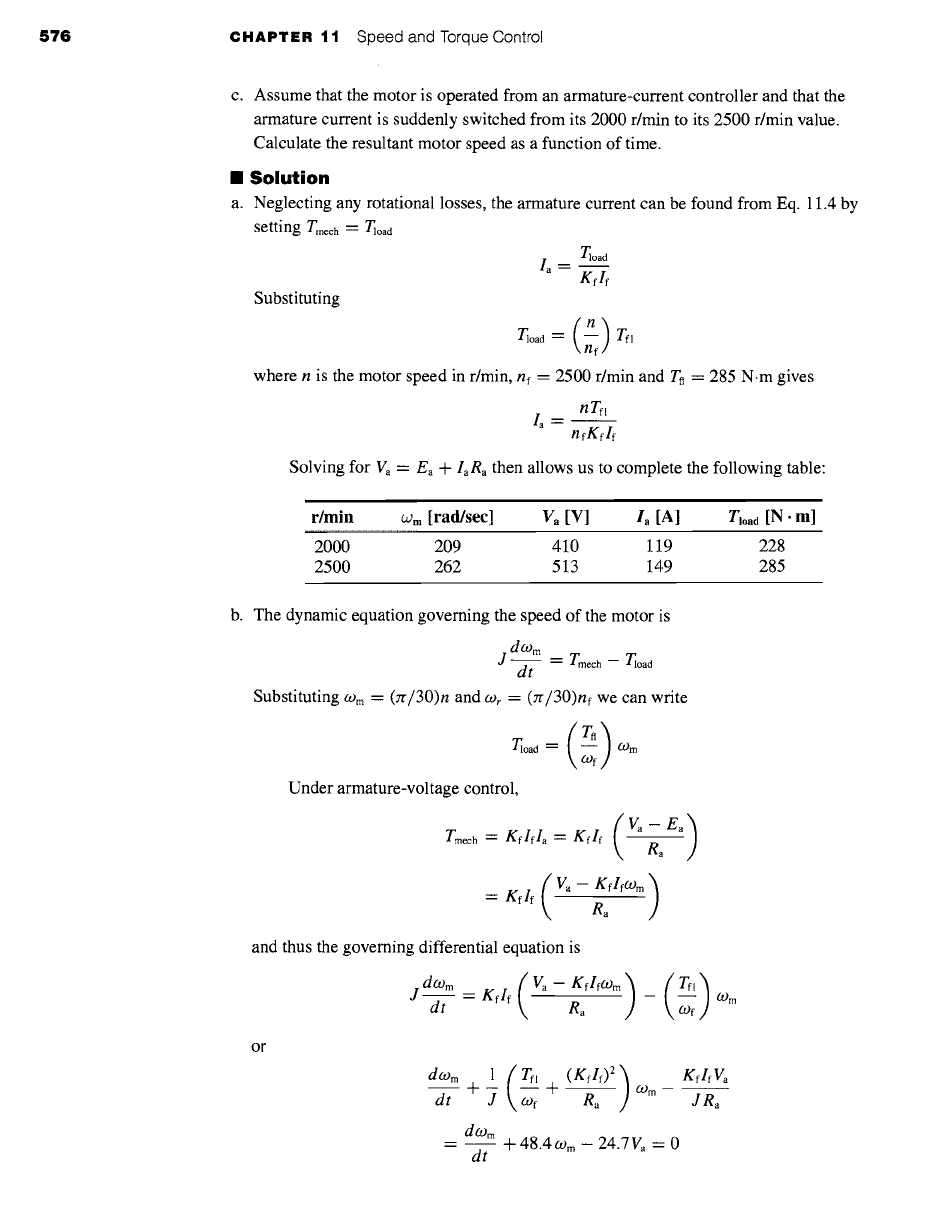
576 CHAPTER 11 Speed and Torque Control
c. Assume that the motor is operated from an armature-current controller and that the
armature current is suddenly switched from its 2000 r/min to its 2500 r/min value.
Calculate the resultant motor speed as a function of time.
I
Solution
a. Neglecting any rotational losses, the armature current can be found from Eq. 11.4 by
setting Tmech = Tload
Substituting
Tload
la=
Kflf
(n)
Tload-- __ Tfl
nf
where n is the motor speed in r/min,
nf "-
2500 r/min and Tn = 285 N.m gives
n Tfl
I.=
nfKflf
Solving for Va
-- Ea -'[- IaRa
then allows us to complete the following table:
r/min
~m
[rad/sec]
V~ [Vl
I a [A] Tload [N" m]
2000 209 410 119 228
2500 262 513 149 285
b. The dynamic equation governing the speed of the motor is
doAm
J--~ = Tm~h-
T, oad
Substituting
O) m "--
(zr/30)n and
OA r ~"
(7r/30)nf we can write
Tl°ad (~)
"-- OAm
Under armature-voltage control,
Tmech-- Kflfla=Kflf ( Va-Ea)ga
Kflf
( Va - RaKflfOAm )
and thus the governing differential equation is
doom (ga-KflfoArn'~)(Tfl)
= R ~ OAm
J --~
Kf If Ra
j OAf
or
doAm
1 (Tn
(Kflf) 2 ) KflfV a
_ ~
_[.. o) m
dt b 7 wf Ra JRa
doAm
dt
+ 48.4
OAm --
24.7 V. = 0

11.1 Control of DC Motors 5"17
From this differential equation, we see that with the motor initially at (Dm
--" (Di =
209 rad/sec, if the armature voltage Va is suddenly switched from Vi = 413 V to
Vf = 513 V, the speed will rise exponentially to
(Dm --" (De =
262 rad/sec as
(Dm -" (.Of + ((Di --
(Df) e-tIt
= 262-
53e -t/~
rad/sec
where r = 1/48.4 = 20.7 msec. Expressed in terms of r/min
n = 2500-
50e -t/r
r/min
The armature current will decrease exponentially with the same 20.7 msec time
constant from an initial value of (Vf -
Vi)/Ra
= 1190 A to its final value of 149 A.
Thus,
Ia = 149 +
1041e -t/~ A
Notice that it is unlikely that the supply to the dc motor can supply this large initial
current (eight times the rated full-load armature current) and, in addition, the high
current and corresponding high torque could potentially cause damage to the dc motor
commutator, brushes, and armature winding. Hence, as a practical matter, a practical
controller would undoubtedly limit the rate of change of the armature voltage to avoid
such sudden steps in voltage, with the result that the speed change would not occur as
rapidly as calculated here.
c. The dynamic equation governing the speed of the motor remains the same as that in
part (b) as does the equation for the load torque. However, in this case, because the motor
is being operated from a current controller, the electromagnetic torque will remain
constant at Tmech --- Tf -- 285 N.m after the current is switched from its initial value of
119 A to its final value of 149 A.
Thus
do) m (Tff)
J~
= Tmech- Tload =
Tf-
O.) m
or
d~-- -~- ~ (Dm j
d(Dm
= + 1.18Wm -- 310 = 0
dt
In this case, the speed will rise exponentially to
(Dm -- (.Of ---
262 rad/sec as
(Dm = (Df + ((Di --
(Df) e-tIt
= 262-
53e -t/~
rad/sec
where now the time constant r -- 1/1.18 - 845 msec.
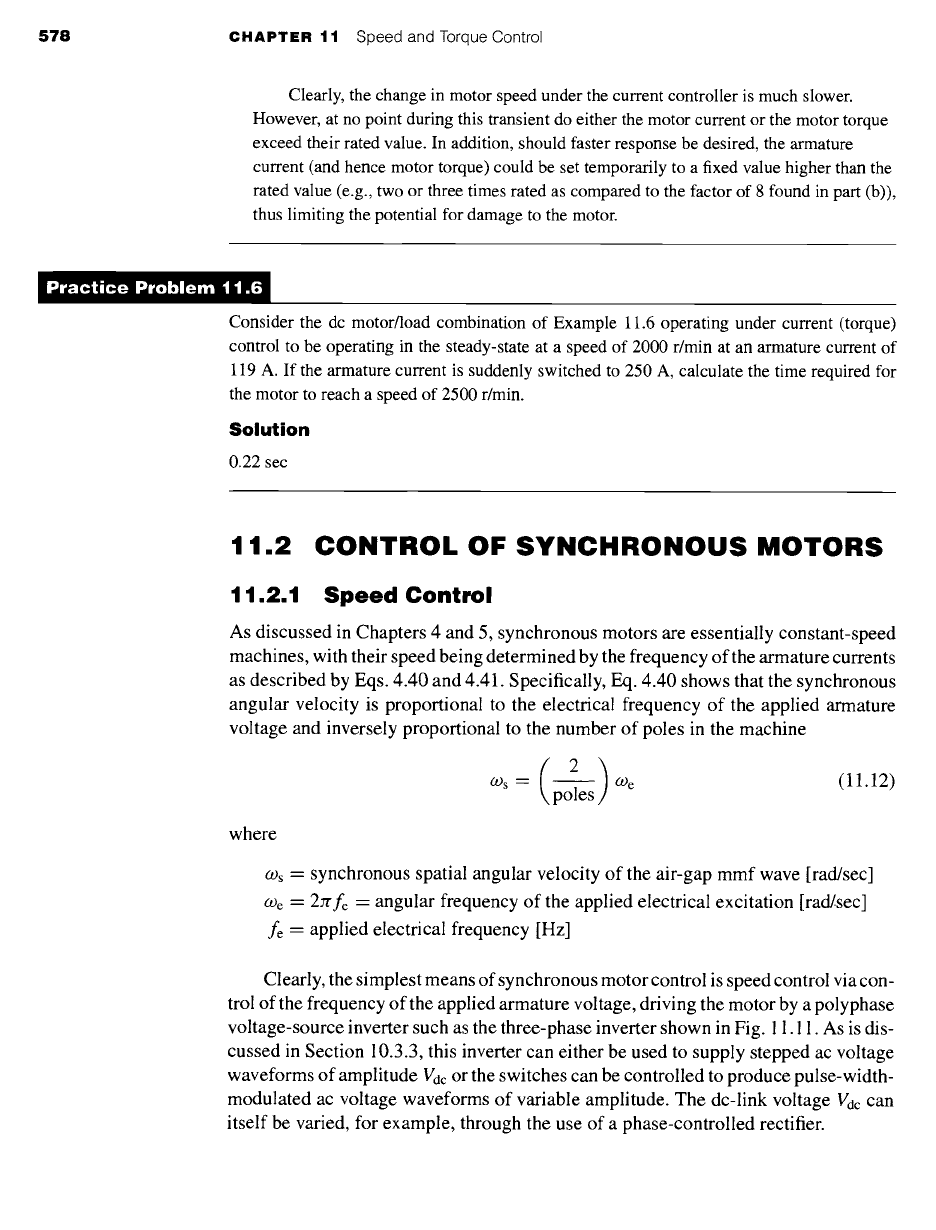
578 CHAPTER 11 Speed and Torque Control
Clearly, the change in motor speed under the current controller is much slower.
However, at no point during this transient do either the motor current or the motor torque
exceed their rated value. In addition, should faster response be desired, the armature
current (and hence motor torque) could be set temporarily to a fixed value higher than the
rated value (e.g., two or three times rated as compared to the factor of 8 found in part (b)),
thus limiting the potential for damage to the motor.
Consider the dc motor/load combination of Example 11.6 operating under current (torque)
control to be operating in the steady-state at a speed of 2000 r/min at an armature current of
119 A. If the armature current is suddenly switched to 250 A, calculate the time required for
the motor to reach a speed of 2500 r/min.
Solution
0.22 sec
11.2 CONTROL OF SYNCHRONOUS MOTORS
1 1.2.1 Speed Control
As discussed in Chapters 4 and 5, synchronous motors are essentially constant-speed
machines, with their speed being determined by the frequency of the armature currents
as described by Eqs. 4.40 and 4.41. Specifically, Eq. 4.40 shows that the synchronous
angular velocity is proportional to the electrical frequency of the applied armature
voltage and inversely proportional to the number of poles in the machine
(2)
COs-- poles
COe
(11.12)
where
cos = synchronous spatial angular velocity of the air-gap mmf wave [rad/sec]
COe =
2n'fe = angular frequency of the applied electrical excitation [rad/sec]
fe = applied electrical frequency [Hz]
Clearly, the simplest means of synchronous motor control is speed control via con-
trol of the frequency of the applied armature voltage, driving the motor by a polyphase
voltage-source inverter such as the three-phase inverter shown in Fig. 11.11. As is dis-
cussed in Section 10.3.3, this inverter can either be used to supply stepped ac voltage
waveforms of amplitude V, tc or the switches can be controlled to produce pulse-width-
modulated ac voltage waveforms of variable amplitude. The dc-link voltage Vdc can
itself be varied, for example, through the use of a phase-controlled rectifier.

11.2 Control of Synchronous Motors 579
Frequency >[Controller]
I I
...... "1
.... ......
3 phase
ac input ~
I
I
+ :
m Vd c I
.1 J
k.. J~,. Jk. ,,/
Y Y
Phase-controlled Dc link Inverter
rectifier
Figure
11.11 Three-phase voltage-source inverter.
3-phase
output
The frequency of the inverter output waveforms can of course be varied by con-
trolling the switching frequency of the inverter switches. For ac-machine applications,
coupled with this frequency control must be control of the amplitude of the applied
voltage, as we will now see.
From Faraday's Law, we know that the air-gap component of the armature voltage
in an ac machine is proportional to the peak flux density in the machine and the
electrical frequency. Thus, if we neglect the voltage drop across the armature resistance
and leakage reactance, we can write
(fe)(Bpeak)Vrate d
(11.13)
Va= frated B rated
where Va is the amplitude of the armature voltage, fe is the operating frequency, and
Bpeak
is the peak air-gap flux density. Vrated, frated, and
Brated are
the corresponding
rated-operating-point values.
Consider a situation in which the frequency of the armature voltage is varied while
its amplitude is maintained at its rated value (Va = Vrated). Under these conditions,
from Eq. 11.13 we see that
Bpeak -- -~e Brated (11.14)
Equation 11.14 clearly demonstrates the problem with constant-voltage, variable-
frequency operation. Specifically, for a given armature voltage, the machine flux
density is inversely proportional to frequency and thus as the frequency is reduced,
the flux density will increase. Thus for a typical machine which operates in saturation
at rated voltage and frequency, any reduction in frequency will further increase the
flux density in the machine. In fact, a significant drop in frequency will increase
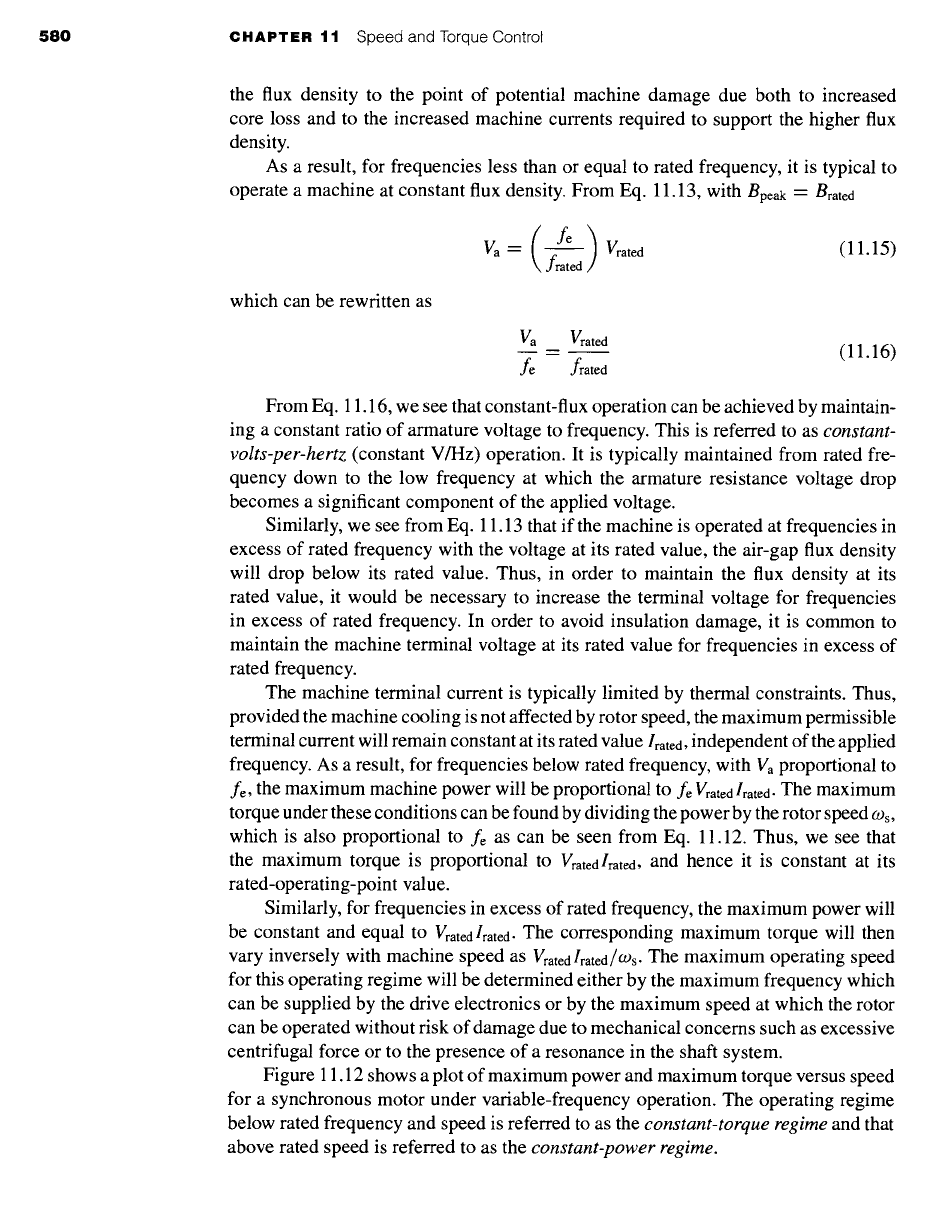
580 CHAPTER 11 Speed and Torque Control
the flux density to the point of potential machine damage due both to increased
core loss and to the increased machine currents required to support the higher flux
density.
As a result, for frequencies less than or equal to rated frequency, it is typical to
operate a machine at constant flux density. From Eq. 11.13, with
Bpeak = Brated
fe
) Vrated
(11.15)
Va-" frated
which can be rewritten as
Va Vrated
~ee = frated
(11.16)
From Eq. 11.16, we see that constant-flux operation can be achieved by maintain-
ing a constant ratio of armature voltage to frequency. This is referred to as constant-
volts-per-hertz (constant V/Hz) operation. It is typically maintained from rated fre-
quency down to the low frequency at which the armature resistance voltage drop
becomes a significant component of the applied voltage.
Similarly, we see from Eq. 11.13 that if the machine is operated at frequencies in
excess of rated frequency with the voltage at its rated value, the air-gap flux density
will drop below its rated value. Thus, in order to maintain the flux density at its
rated value, it would be necessary to increase the terminal voltage for frequencies
in excess of rated frequency. In order to avoid insulation damage, it is common to
maintain the machine terminal voltage at its rated value for frequencies in excess of
rated frequency.
The machine terminal current is typically limited by thermal constraints. Thus,
provided the machine cooling is not affected by rotor speed, the maximum permissible
terminal current will remain constant at its rated value/rated, independent of the applied
frequency. As a result, for frequencies below rated frequency, with Va proportional to
fe, the maximum machine power will be proportional to fe
Vrated/rated.
The maximum
torque under these conditions can be found by dividing the power by the rotor speed COs,
which is also proportional to fe as can be seen from Eq. 11.12. Thus, we see that
the maximum torque is proportional to
Vratedlrated,
and hence it is constant at its
rated-operating-point value.
Similarly, for frequencies in excess of rated frequency, the maximum power will
be constant and equal to
Vratedlrated .
The corresponding maximum torque will then
vary inversely with machine speed
as
VratedIrated/COs .
The maximum operating speed
for this operating regime will be determined either by the maximum frequency which
can be supplied by the drive electronics or by the maximum speed at which the rotor
can be operated without risk of damage due to mechanical concerns such as excessive
centrifugal force or to the presence of a resonance in the shaft system.
Figure 11.12 shows a plot of maximum power and maximum torque versus speed
for a synchronous motor under variable-frequency operation. The operating regime
below rated frequency and speed is referred to as the constant-torque regime and that
above rated speed is referred to as the constant-power regime.
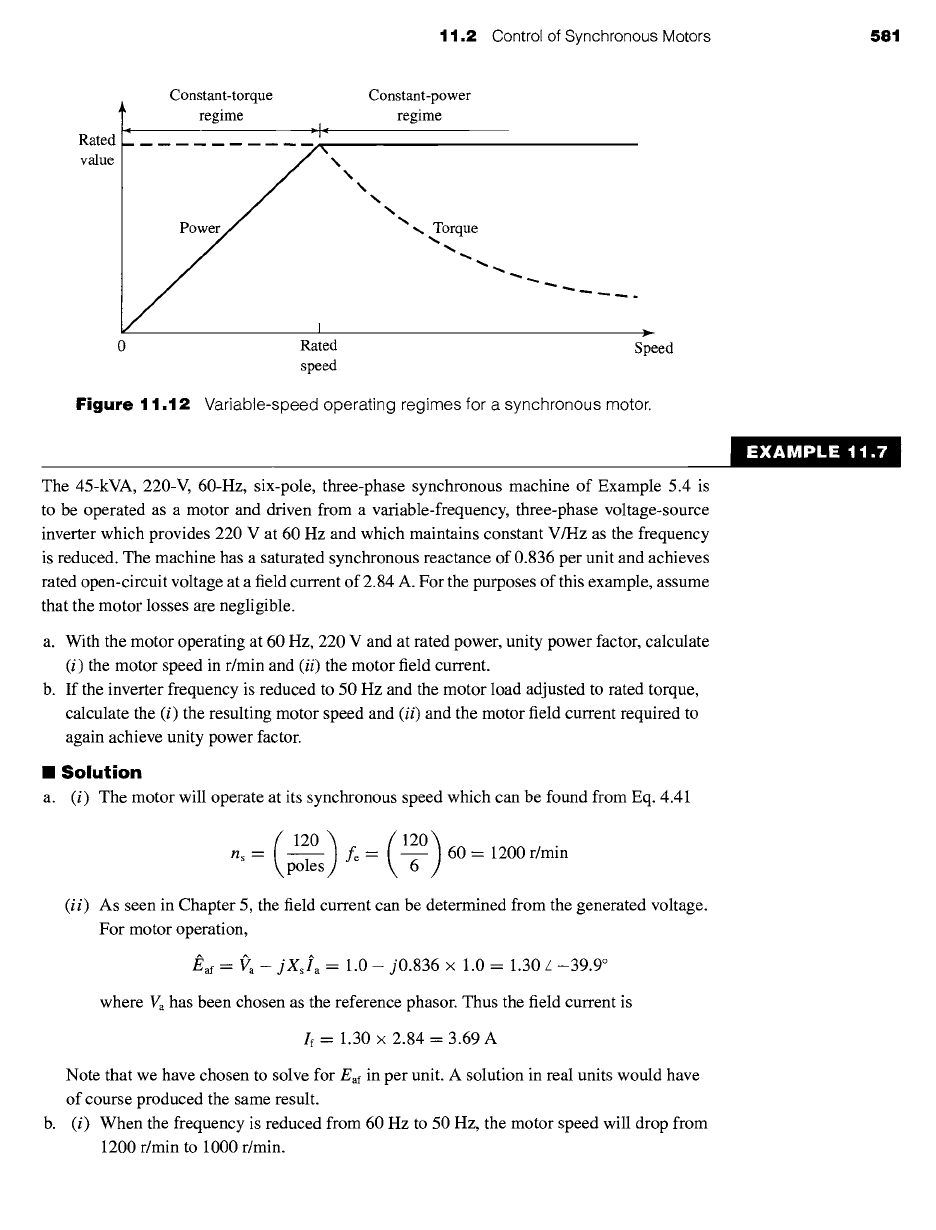
11.2 Control of Synchronous Motors
581
Rated
value
Constant-torque
regime
\
Power
,
Rated
speed
Constant-power
regime
Torque
r
Speed
Figure
11.12 Variable-speed operating regimes for a synchronous motor.
The 45-kVA, 220-V, 60-Hz, six-pole, three-phase synchronous machine of Example 5.4 is
to be operated as a motor and driven from a variable-frequency, three-phase voltage-source
inverter which provides 220 V at 60 Hz and which maintains constant V/Hz as the frequency
is reduced. The machine has a saturated synchronous reactance of 0.836 per unit and achieves
rated open-circuit voltage at a field current of 2.84 A. For the purposes of this example, assume
that the motor losses are negligible.
a. With the motor operating at 60 Hz, 220 V and at rated power, unity power factor, calculate
(i) the motor speed in r/min and
(ii)
the motor field current.
b. If the inverter frequency is reduced to 50 Hz and the motor load adjusted to rated torque,
calculate the (i) the resulting motor speed and
(ii)
and the motor field current required to
again achieve unity power factor.
I Solution
a. (i) The motor will operate at its synchronous speed which can be found from Eq. 4.41
ns = ~ /
fe -- ~
60 = 1200 r/min
(ii)
As seen in Chapter 5, the field current can be determined from the generated voltage.
For motor operation,
E, af-- Va- j Xsla
=
1.0- j0.836 x 1.0 = 1.30 L--39.9 °
where Va has been chosen as the reference phasor. Thus the field current is
If = 1.30 x 2.84 = 3.69 A
Note that we have chosen to solve for Eaf in per unit. A solution in real units would have
of course produced the same result.
b. (i) When the frequency is reduced from 60 Hz to 50 Hz, the motor speed will drop from
1200 r/min to 1000 r/min.
EXAMPLE 11.7
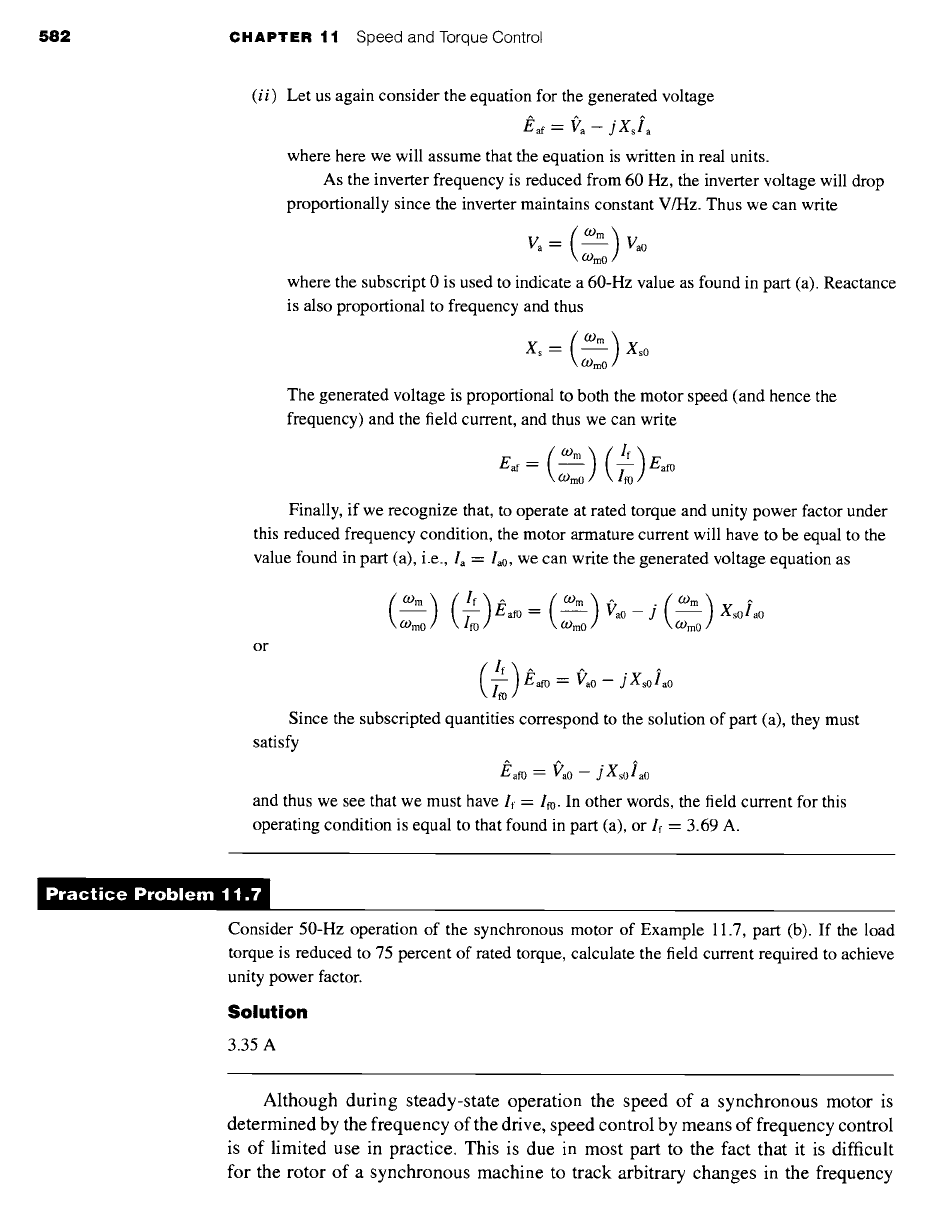
582 CHAPTER 11 Speed and Torque Control
(ii)
Let us again consider the equation for the generated voltage
#af-- Va - jXs[a
where here we will assume that the equation is written in real units.
As the inverter frequency is reduced from 60 Hz, the inverter voltage will drop
proportionally since the inverter maintains constant V/Hz. Thus we can write
Va-- ~m0 Va0
where the subscript 0 is used to indicate a 60-Hz value as found in part (a). Reactance
is also proportional to frequency and thus
Xs = ~mO Xs0
The generated voltage is proportional to both the motor speed (and hence the
frequency) and the field current, and thus we can write
If
Eaf: (~00)(-T~) EafO
Finally, if we recognize that, to operate at rated torque and unity power factor under
this reduced frequency condition, the motor armature current will have to be equal to the
value found in part (a), i.e., la = lao, we can write the generated voltage equation as
( O)rn )O)m0 (~)#af0 = ( O')m )O.)m0 l~ra0- j (~mm0)Xs0ia0
or
('~) #af0--" l~a0--jXs0ia0
Since the subscripted quantities correspond to the solution of part (a), they must
satisfy
/~af0 = ~0 - j X~olao
and thus we see that we must have It = If0. In other words, the field current for this
operating condition is equal to that found in part (a), or If = 3.69 A.
)ractice Problem 1 1.'
Consider 50-Hz operation of the synchronous motor of Example 11.7, part (b). If the load
torque is reduced to 75 percent of rated torque, calculate the field current required to achieve
unity power factor.
Solution
3.35 A
Although during steady-state operation the speed of a synchronous motor is
determined by the frequency of the drive, speed control by means of frequency control
is of limited use in practice. This is due in most part to the fact that it is difficult
for the rotor of a synchronous machine to track arbitrary changes in the frequency
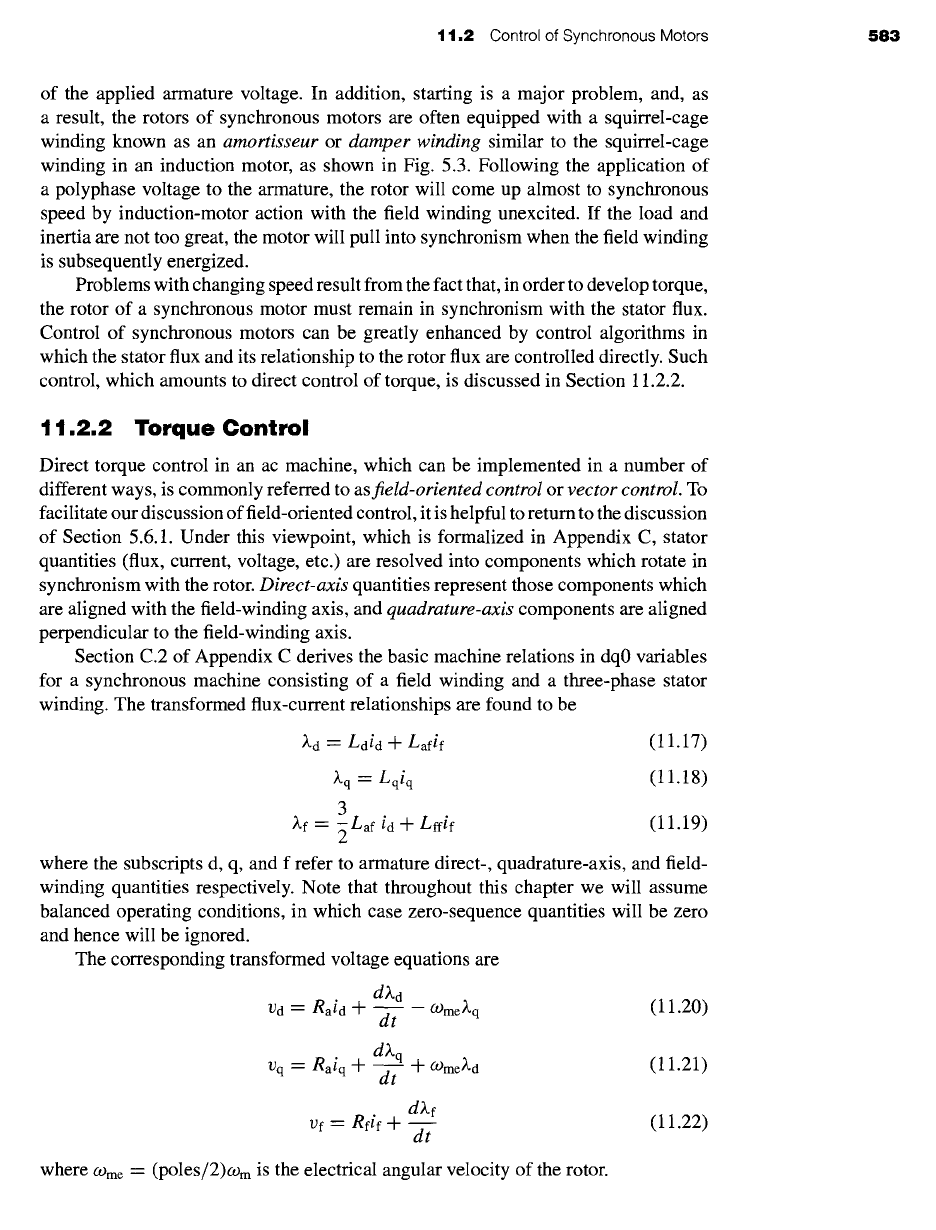
11.2 Control of Synchronous Motors 583
of the applied armature voltage. In addition, starting is a major problem, and, as
a result, the rotors of synchronous motors are often equipped with a squirrel-cage
winding known as an amortisseur or damper winding similar to the squirrel-cage
winding in an induction motor, as shown in Fig. 5.3. Following the application of
a polyphase voltage to the armature, the rotor will come up almost to synchronous
speed by induction-motor action with the field winding unexcited. If the load and
inertia are not too great, the motor will pull into synchronism when the field winding
is subsequently energized.
Problems with changing speed result from the fact that, in order to develop torque,
the rotor of a synchronous motor must remain in synchronism with the stator flux.
Control of synchronous motors can be greatly enhanced by control algorithms in
which the stator flux and its relationship to the rotor flux are controlled directly. Such
control, which amounts to direct control of torque, is discussed in Section 11.2.2.
1 1.2.2 Torque Control
Direct torque control in an ac machine, which can be implemented in a number of
different ways, is commonly referred to asfield-oriented control or vector control. To
facilitate our discussion of field-oriented control, it is helpful to return to the discussion
of Section 5.6.1. Under this viewpoint, which is formalized in Appendix C, stator
quantities (flux, current, voltage, etc.) are resolved into components which rotate in
synchronism with the rotor. Direct-axis quantities represent those components which
are aligned with the field-winding axis, and quadrature-axis components are aligned
perpendicular to the field-winding axis.
Section C.2 of Appendix C derives the basic machine relations in dq0 variables
for a synchronous machine consisting of a field winding and a three-phase stator
winding. The transformed flux-current relationships are found to be
)~d -- Ldid +
Lafif
(11.17)
(11.18)
where
(-Ome --
(poles/2)Wm is the electrical angular velocity of the rotor.
Xq-- Lqiq
3
Xf = ~ Laf id n t-
Lffif
(11.19)
where the subscripts d, q, and f refer to armature direct-, quadrature-axis, and field-
winding quantities respectively. Note that throughout this chapter we will assume
balanced operating conditions, in which case zero-sequence quantities will be zero
and hence will be ignored.
The corresponding transformed voltage equations are
dXd
Vd -- Raid + d--T
-
O)me•q (11.20)
dXq
Vq
=
Raiq q- -~ Jr-
O)me/~d (11.21)
dXf
Vf "-- Rfif
+ (11.22)
dt
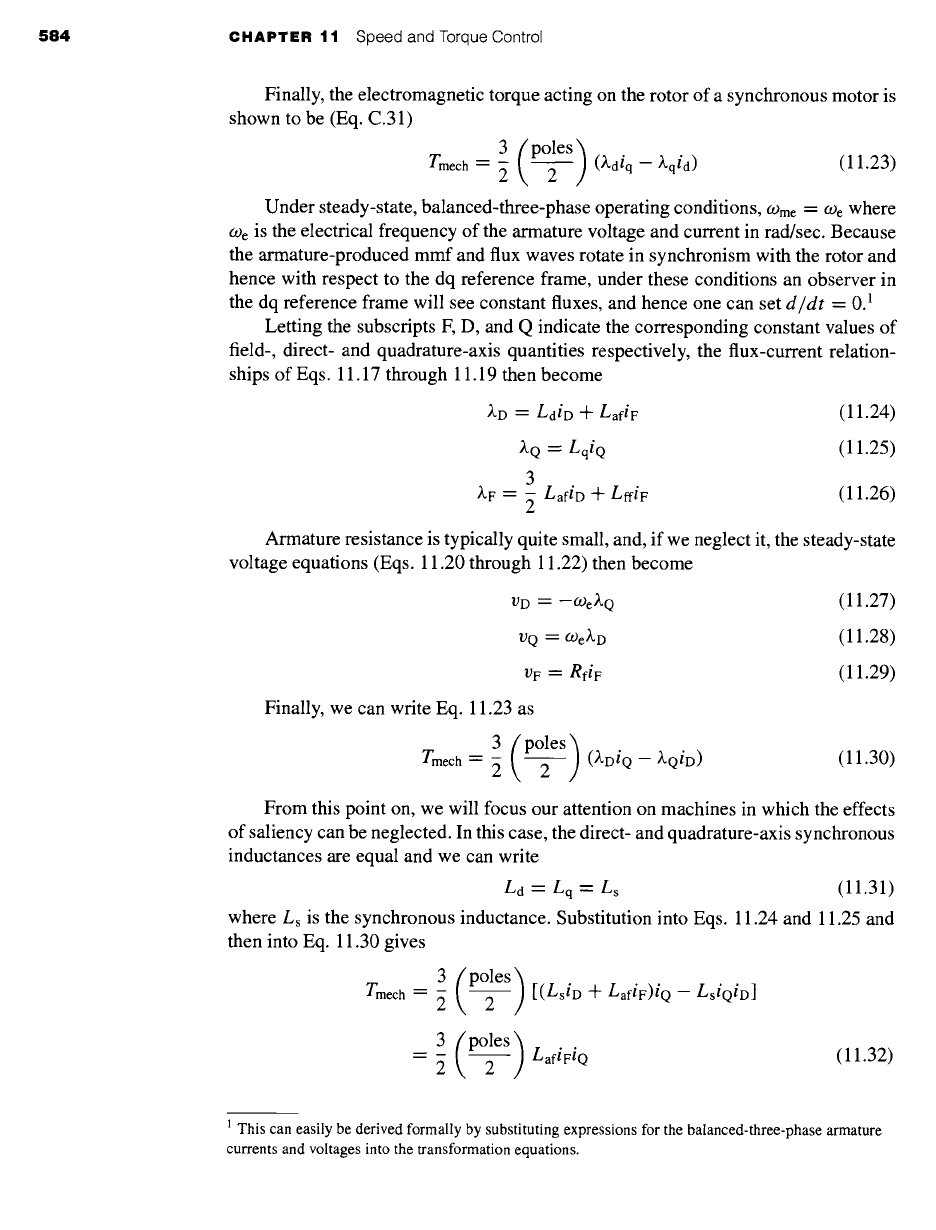
584 CHAPTER 11 Speed and Torque Control
Finally, the electromagnetic torque acting on the rotor of a synchronous motor is
shown to be (Eq. C.31)
3 (P°21es)
Tmech = ~ ()~diq -- ~.qid) (11.23)
Under steady-state, balanced-three-phase operating conditions,
09me = 60 e
where
O) e is
the electrical frequency of the armature voltage and current in rad/sec. Because
the armature-produced mmf and flux waves rotate in synchronism with the rotor and
hence with respect to the dq reference frame, under these conditions an observer in
the dq reference frame will see constant fluxes, and hence one can set
d/dt
= 0.1
Letting the subscripts F, D, and Q indicate the corresponding constant values of
field-, direct- and quadrature-axis quantities respectively, the flux-current relation-
ships of Eqs. 11.17 through 11.19 then become
'~D = LdiD +
LafiF (11.24)
~,Q = LqiQ
(11.25)
3
~.F = ~ LafiD -+-
LffiF
(11.26)
Armature resistance is typically quite small, and, if we neglect it, the steady-state
voltage equations (Eqs. 11.20 through 11.22) then become
p D = -O)e)~ Q (11.27)
UQ = O)e~. D (11.28)
1)F =
RfiF
(11.29)
Finally, we can write Eq. 11.23 as
3 (p°les) ()~DiQ -- ~.QiD) (1130)
Tmech = ~ 2
From this point on, we will focus our attention on machines in which the effects
of saliency can be neglected. In this case, the direct- and quadrature-axis synchronous
inductances are equal and we can write
Ld = Lq = Ls (11.31)
where Ls is the synchronous inductance. Substitution into Eqs. 11.24 and 11.25 and
then into Eq. 11.30 gives
(po,es)
Tmech = ~ 2 [(LsiD +
LafiF)iQ- LsiQiD]
----3 (p°les) LafiFiQ-2 2
(11.32)
1 This can easily be derived formally by substituting expressions for the balanced-three-phase armature
currents and voltages into the transformation equations.
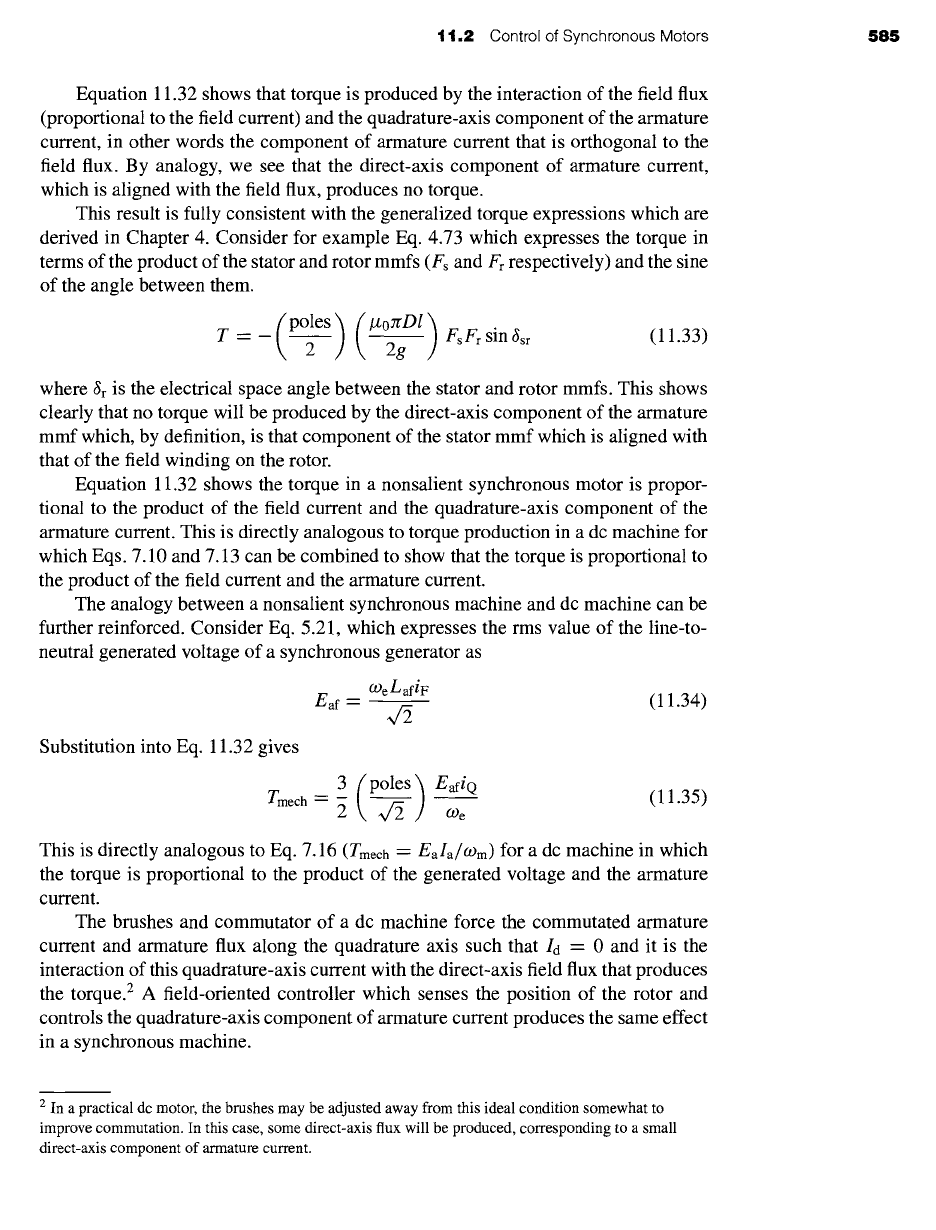
t 1.2 Control of Synchronous Motors 585
Equation 11.32 shows that torque is produced by the interaction of the field flux
(proportional to the field current) and the quadrature-axis component of the armature
current, in other words the component of armature current that is orthogonal to the
field flux. By analogy, we see that the direct-axis component of armature current,
which is aligned with the field flux, produces no torque.
This result is fully consistent with the generalized torque expressions which are
derived in Chapter 4. Consider for example Eq. 4.73 which expresses the torque in
terms of the product of the stator and rotor mmfs (Fs and Fr respectively) and the sine
of the angle between them.
T= (P°21es) (/z°zrD/~
- 2g ,] FsFrsinSsr (11.33)
where 8r is the electrical space angle between the stator and rotor mmfs. This shows
clearly that no torque will be produced by the direct-axis component of the armature
mmf which, by definition, is that component of the stator mmf which is aligned with
that of the field winding on the rotor.
Equation 11.32 shows the torque in a nonsalient synchronous motor is propor-
tional to the product of the field current and the quadrature-axis component of the
armature current. This is directly analogous to torque production in a dc machine for
which Eqs. 7.10 and 7.13 can be combined to show that the torque is proportional to
the product of the field current and the armature current.
The analogy between a nonsalient synchronous machine and dc machine can be
further reinforced. Consider Eq. 5.21, which expresses the rms value of the line-to-
neutral generated voltage of a synchronous generator as
coeLafiF
Ear = (11.34)
Substitution into Eq. 11.32 gives
3 (poles ~ EafiQ (11.35)
rmech = 2 ~ ~ ,] (De
This is directly analogous to Eq. 7.16
(Tmech = Eala/cOm)
for a dc machine in which
the torque is proportional to the product of the generated voltage and the armature
current.
The brushes and commutator of a dc machine force the commutated armature
current and armature flux along the quadrature axis such that Id = 0 and it is the
interaction of this quadrature-axis current with the direct-axis field flux that produces
the torque. 2 A field-oriented controller which senses the position of the rotor and
controls the quadrature-axis component of armature current produces the same effect
in a synchronous machine.
2 In a practical dc motor, the brushes may be adjusted away from this ideal condition somewhat to
improve commutation. In this case, some direct-axis flux will be produced, corresponding to a small
direct-axis component of armature current.
